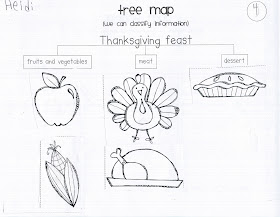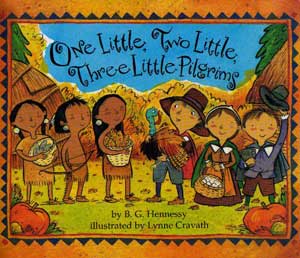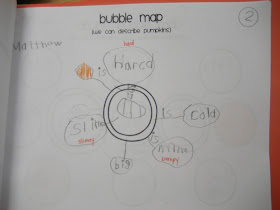I realize that I am far too behind on this post but this year has been one of those "keep your head above water" years. Going from early bird/late bird to AM/PM has been a big adjustment and I feel so behind all the time! Anyway, here is the fun we've been having in our room in the past month.
Pumpkins
Our school is all about Thinking Maps this year in an effort to begin
the preparations for CCSS. I decided that in addition to the daily maps
that we use, I wanted to pick a topic and go deep with it using every
map. Since it was October, pumpkins were an easy choice. After all 8
maps, writing, and a table of contents, our pumpkin books were born!
We used a sponge to paint the cover and give it a composition book feel.
We completed the table of contents last, by cutting and gluing.
Our circle map organized our prior knowledge. The kids did this independently as a starter to the unit. This friend knew that pumpkins could have faces, seeds, and lines; and could be yellow or orange.
Next, we worked in small groups to make the bubble map. I cut open a pumpkin and gave them a chance to explore and talk abut what they noticed.
Later, we compared and contrasted a small orange pumpkin and a large white pumpkin.
Then we used some cut-outs to organize information about pumpkins.
We read a book about the life cycle of pumpkins and then drew the sequence.
We cut open another large pumpkin in half, from top to bottom to look inside. We talked about the different parts.
We thought about what makes pumpkins grow (seeds, soil, water, sun) and what happens after it grows (it can be a jack-o-lantern, pie, or toasted seeds).
We took what we knew about pumpkins and related it to other things. A pumpkin is the color orange as an apple is the color red, as a strawberry is the color red, and as grapes are the color purple. The kids chose fruits and veggies to use.
Finally, we wrote. The students started with a picture, labeled it, and wrote one or two sentences.
We are currently in the process of a similar book for Thanksgiving...stay tuned!
Bats and Spiders
We started with bats after we finished up with the pumpkins. Our short unit included watching videos from United Streaming, looking at pictures online, reading books, and group discussion. We mapped out our thinking as we went along, and finished with some group writing.
We regularly use a circle map in place of a KWL. The red is what we already knew and the blue is what we learned along the way. We recorded our questions on another chart. What I love about thinking maps is that not only does this capture what we know, it also has the frame of reference: how we know what we know. When my kids offered answers and suggestions, I asked them where they got the information. They said TV, computers, the zoo, books, and seeing things. I love that "I just know" is no longer an acceptable answer!
Next, we wanted to classify the information we found to further organize it and make sense of it all. We used a tree map to do so.
The tree map is a great tool for writing because it transitions smoothly to simple sentence structures. From this, my kiddos were able to easily compose sentences that would have otherwise been too difficult to write by themselves.
I wrote some of the key words on sentence strips and asked kids to come up, pick the words they needed, and write the detail to complete the sentence. They wrote them as the tree map was posted on the SMARTboard. One friend even came up with his own sentence, which he added.
After we explored bats for a few days, we moved on to spiders. We made a new circle map and used it in the same way.
My favorite comment from this one was, "We step on them!" Yes, many people do step on them- but more importantly, I was getting real-life examples of their background knowledge. They were making connections to their lives and building their schema.
Now that we had information from several sources about both topics, we were ready to compare and contrast. For this, we used a double bubble map. We pair/shared things we remembered talking about. When someone offered a piece of information, I asked them where it should go. Understanding the placement of information here is key. It shows me that they understand (or don't) that some information only pertains to one of the creatures while other information related to both. We also added the verbs so that writing would be a breeze later.

We composed this paragraph over the next couple days. I put key words on the bottom and called on kids to come up and drag them to the top to create sentences. We read through it over and over, and I added pictures to help. As a text, this is WAY above my students' reading levels and would normally not be considered a grade-level-appropriate text. However, because we spent so much time with the information and composed it from what we found, the kids could absolutely read it when we finished.
I love color coding so we also went back and colored the capitals green (because that is where the sentence starts to go!) The next step would be revising to improve the flow and structure. I'll wait a little longer before introducing that though :)
I have now done a few units in this fashion at both the beginning of the year and the end. They are great for teaching informative writing. My newest discovery though is that they also (miraculously) align quite closely to the structure of a performance task on the CCSS tests! I am on a committee for my district and I'm also participating in Writing Project 2 at UCI, so I have been talking about the Common Core a lot! I have looked at some of the sample performance tasks and they have a very similar format to these units. First a video or article is given to the students and they can take notes. Then there is a class discussion about the topic and student are encouraged to use a graphic organizer for the information. Then students may be given one more genre on the topic. Finally, they are asked to take that information and write about it. I am thrilled that my kinders (the first guinea pigs to be tested in 3rd grade and all the way through) will already have experience doing this type of activity!























































